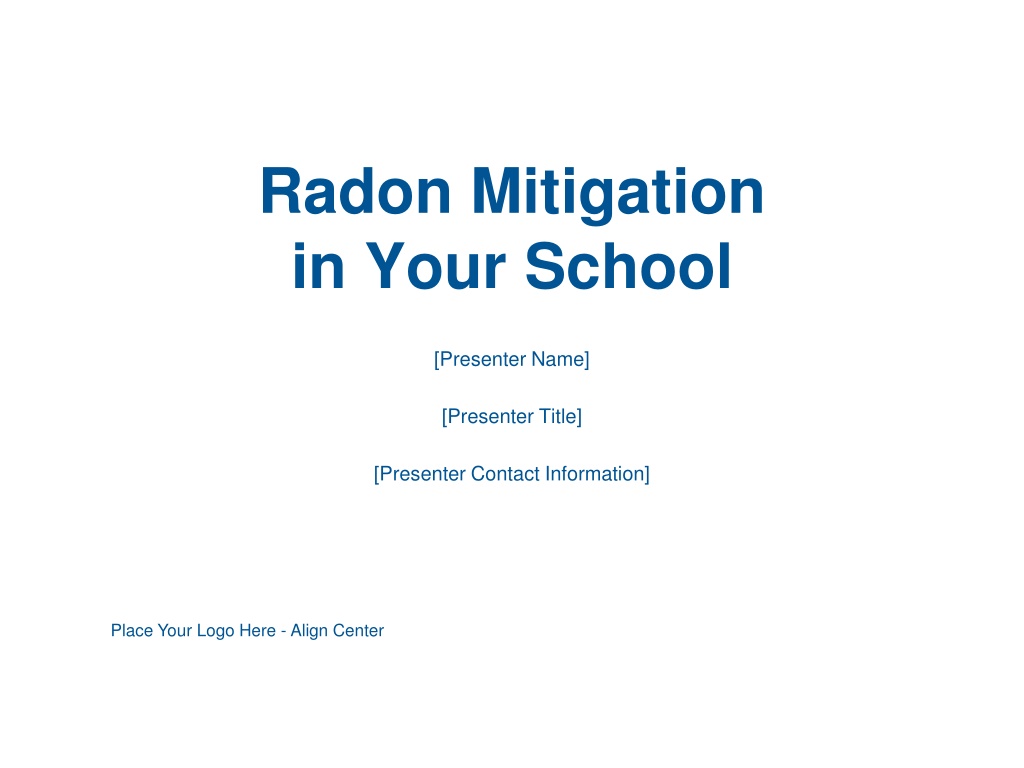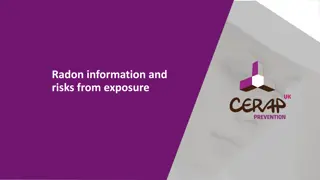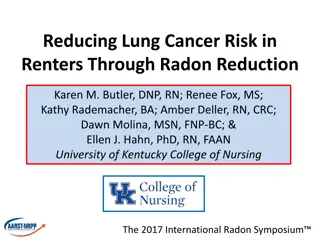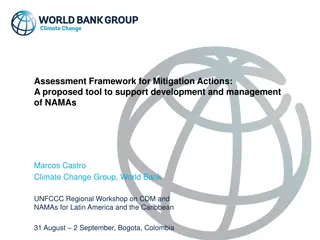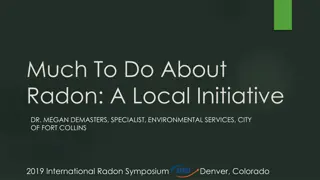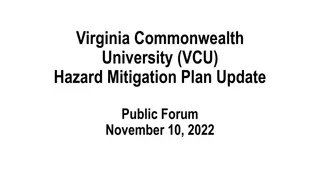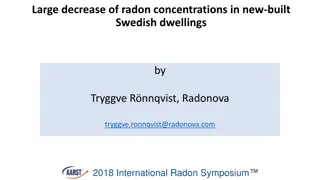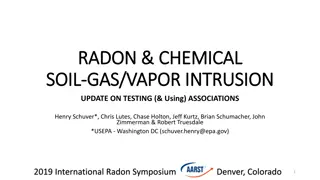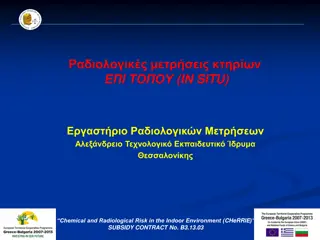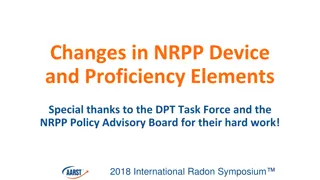Understanding Radon Mitigation in Schools
Exploring the dangers of radon exposure in schools, this presentation covers the radioactive gas's link to lung cancer, how it affects indoor spaces, and the importance of testing for radon levels. Learn about the risks of radon gas, its connection to smoking, and the measures recommended by EPA and health authorities to ensure school safety. Discover why radon testing is crucial, the laws around radon in schools, and how radon levels are measured. Educate yourself on the impact of radon on lung health and the steps needed to mitigate its harmful effects in educational settings.
Download Presentation

Please find below an Image/Link to download the presentation.
The content on the website is provided AS IS for your information and personal use only. It may not be sold, licensed, or shared on other websites without obtaining consent from the author. Download presentation by click this link. If you encounter any issues during the download, it is possible that the publisher has removed the file from their server.
E N D
Presentation Transcript
Radon Mitigation in Your School [Presenter Name] [Presenter Title] [Presenter Contact Information] Place Your Logo Here - Align Center
Radon Review Radioactive gas Colorless, odorless, tasteless Occurs naturally, decay product of uranium Found all over the world Group A carcinogen lung cancer 2ndleading cause of lung cancer, after smoking No immediate health effects 2
Cancer Types and Estimated U.S. Deaths, 2015 Image Source: Testing for Elevated Radon in Schools: A Protocol and Plan 3
Radon and Smoking Image Source: CDC Radon Toolkit for Public Health Professionals 4
How does radon cause lung cancer? When you breathe in radon gas, the radioactive particles can get trapped in your lungs. Over time, they cause lung cancer. The risk from radon depends on two things: How much: High radon levels are more dangerous How long: The more contact you have with radon gas, the greater your risk. 5
Where do we spend our time? EPA shows that we spend 87.9% of our time indoors on a daily basis. Home is likely the most significant source of radon exposure School is the second largest contributor for most school children and staff *Source: U.S. Environmental Protection Agency Image Source: CDC Radon Toolkit for Public Health Professionals 6
Who Should Test for Radon? The EPA and Oregon Health Authority (OHA) recommend that every home and school be tested for radon. 7
Oregon Law Radon in Schools ORS 332.166-167 OHA to give radon info to each school district School districts required to submit testing plans by September 2016 and perform initial testing before January 1, 2021 8
How is radon measured? Radon is measured in Picocuries per Liter (pCi/L) EPA recommends taking corrective action if levels are 4 pCi/L or above No safe level of radon exposure 9
[Insert school or district name] Radon Test Results [Insert school or district name] began testing on [insert date], and [insert radon company] was hired to help conduct monitoring and mitigation procedures. Radon testing devices were placed in [insert # of rooms] [Insert # of rooms] rooms had results greater than the EPA action level of 4.0 pCi/L Rooms that tested above the action level are subject to longer confirmation testing and mitigation Results can be found online: [insert web link] 10
Radon Mitigation Any system or steps designed to reduce the radon level in the indoor air of a building While ORS 332.166-167 does not specifically require mitigation of elevated radon in schools, both EPA and OHA strongly suggest that rooms with follow-up measurements above 4.0 pCi/L be mitigated It is likely impossible to reduce a school s radon level to zero; the goal of radon reduction is harm reduction 11
Types of Mitigation Systems Soil depressurization Building pressurization HVAC system adjustments Sealing entry routes Zone-specific ventilation Image Source: Testing for Elevated Radon in Schools: A Protocol and Plan 12
Soil Depressurization Also known as sub-slab suction Most common in home mitigation A suction fan is used to produce a low- pressure field in soil under the building slab Prevents radon entry by ventilating the gas outside before it has a chance to get drawn into the building Image Source: www.epa.gov/radon 13
Building Pressurization Blocks radon entry routes due to air pressure barriers, where air is pushed out of the building from inside [Insert graphic] More outdoor air is given than is used so the building is slightly pressurized compared to both the outside of the building and the sub-soil area Often used as a temporary fix and/or in combination with other mitigation systems 14
Building Pressurization HVAC Adjustments Adjustments to heating, ventilation and air conditioning systems serving a room [Insert graphic] Tend to have a greater impact on radon levels in schools than in homes Most effective and frequently used type of mitigation for radon reduction in existing school buildings 15
Sealing Entry Route Zones Often used in combination with other mitigation techniques Entry routes may include: 1. Cracks in solid floors 2. Construction joints 3. Cracks in walls 4. Gaps in suspended floors 5. Gaps around pipes 6. Cavities inside walls 7. Water supply Image Source: www.epa.gov/radon Minimizes radon entry, not a stand-alone mitigation method 16
Zone-specific Ventilation The use of a building s crawlspaces, tunnels, conduits, vaults, etc. in designing a mitigation system that reduces radon [Insert graphic] Usually used in combination with other types of systems 17
Mitigation Plan [Insert school or district name] will begin radon mitigation on [insert date] Mitigation steps will include: [e.g. A radon mitigation contractor will complete confirmation testing] [e.g. Initial and interim mitigation efforts will include running the HVAC system 24/7 ] Systems are usually effective within 24 hours of installation Mitigation estimated completion date is [insert date] Image Source: www.epa.gov/radon 18
How can YOU help? Spread the word educate others on radon, testing and mitigation Cooperate with facilitating staff and radon professionals while radon mitigation is occurring Contact and/or refer questions and concerns to [insert name, such as the health and safety coordinator] Image Source: www.epa.gov/radon 19
Test your own home! You can find do-it-yourself test kits at: Local hardware stores The American Lung Association www.lung.org/radon; 503-718-6141 National Radon Program at Kansas State University www.sosradon.org; 1-800-SOS-RADON Oregon Radon Awareness Program offers free test kits contact radon.program@state.or.us to find out if you are eligible 20
Resources [insert school or district contact name and information, such as the health and safety coordinator] Oregon Radon Awareness Program www.healthoregon.org/radon; 971-673-0440 Environmental Protection Agency (EPA) www.epa.gov/radon National Radon Program at Kansas State University www.sosradon.org; 1-800-SOS-RADON 21
